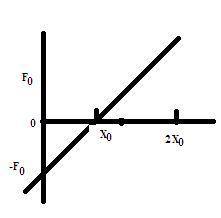
Physics, 05.08.2019 20:20 victoriagreeneov7l9o
The force on a particle is directed along an x axis and given by f = f0(x/x0 - 1) where x is in meters and f is in newtons. if f0 = 0.98 n and x0 = 4.9 m, find the work done by the force in moving the particle from x = 0 to x = 2x0 m.

Answers: 1


Another question on Physics

Physics, 22.06.2019 08:00
The arrival of in the early days of europa’s existence could have formed its ocean. it is likely that the water experienced similar to earth. it is also possible that this water is retained beneath europa’s surface and in its atmosphere due to europa’s . 1.) a. precipitation b. water vapor c. icy debris 2.) a. gravitational compression b. biochemical cycling c. radiogenic heating 3.) a, gravity b. magnetic field c. heat energy for plato
Answers: 3

Physics, 22.06.2019 12:30
What would be the strength of earth's gravitational field at a point where an 80.0 kg astronaut would experience a 80% reduction in weight
Answers: 3

Physics, 22.06.2019 12:50
Air is contained in a variable-load piston-cylinder device equipped with a paddle wheel. initially, air is at 400 kpa and 17°c. the paddle wheel is now turned by an external electric motor until 75 kj/kg of work has been transferred to air. during this process, heat is transferred to maintain a constant air temperature while allowing the gas volume to triple. calculate the required amount of heat transfer in kj/kg.
Answers: 2

Physics, 22.06.2019 20:00
Aspectroscope breaks light up into its colors, allowing scientists to analyze light from the solar system and universe. by studying the spectral line patterns, widths, strengths and positions, scientists can determine the speed, position, and of celestial bodies. a) age b) origin c) rotation d) temperature
Answers: 1
You know the right answer?
The force on a particle is directed along an x axis and given by f = f0(x/x0 - 1) where x is in mete...
Questions



Mathematics, 29.07.2019 06:20


History, 29.07.2019 06:20

English, 29.07.2019 06:20



History, 29.07.2019 06:20



English, 29.07.2019 06:20






Computers and Technology, 29.07.2019 06:20


![\int\limits^{9.8}_00.98\times[(x/4.9) - 1]} \, dx](/tpl/images/0171/8030/bd12a.png)
![0.98\times[(x^2/4.9 - x)]^{9.8}_0](/tpl/images/0171/8030/d0ef2.png)



